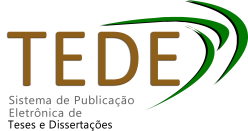| Compartilhamento |


|
Use este identificador para citar ou linkar para este item:
http://www.bdtd.ueg.br/handle/tede/1046Registro completo de metadados
| Campo DC | Valor | Idioma |
|---|---|---|
| dc.creator | Muniz, Paulo Henrique Pereira Costa | - |
| dc.creator.Lattes | http://lattes.cnpq.br/0778356460541619 | por |
| dc.contributor.advisor1 | Carvalho, Daniel Diego Costa | - |
| dc.contributor.advisor1Lattes | http://lattes.cnpq.br/1929545243803511 | por |
| dc.contributor.referee1 | Carvalho, Daniel Diego Costa | - |
| dc.contributor.referee2 | Duarte, Elizabeth Amélia Alves | - |
| dc.contributor.referee3 | Oliveira, hiago Alves Santos de | - |
| dc.date.accessioned | 2022-05-02T10:55:48Z | - |
| dc.date.issued | 2022-01-25 | - |
| dc.identifier.citation | MUNIZ, Paulo Henrique Pereira Costa. Fotomorfogênese e Patogenicidade de Bipolaris bicolor em trigo, milho e sorgo. 2022. 72 f. Dissertação (Mestrado em Produção Vegetal) - Unidade Ipameri, Universidade Estadual de Goiás, Ipameri-GO. | por |
| dc.identifier.uri | http://www.bdtd.ueg.br/handle/tede/1046 | - |
| dc.description.resumo | O patógeno Bipolaris bicolor apresenta grande importância no ciclo de produção de diversas culturas agrícolas acarretando grandes perdas de produtividade. Afim de construir modelos epidemiológicos de populações de um patógeno é necessário o estudo de sua variabilidade patogênica e as respostas fisiológicas à estímulos de fatores físicos, pois apresenta importância crucial em seu manejo. Neste contexto, objetivou-se realizar a caracterização fisiológica e verificar a patogenicidade de seis cepas de B. bicolor. A avaliação fisiológica consitiu na avaliação da influência da luz na germinação conidial. Para tanto, suspensão com concentração de 1,6 x 105 conídios/mL de conídios das seis cepas de B. bicolor foram inoculados em placas de Petri contendo meio Ágar-água e incubados em dois regimes luminosos: escuro e luminosidade constantes, em delineamento inteiramente casualizado (DIC) em arranjo fatorial 6x2, sendo seis cepas de B. bicolor e dois regimes físicos com cinco repetições. Avaliou-se o comprimento do tubo germinativo dos conídios por 5 h. Adicionalmente, para a caracterização do patossistema e sua fisiologia, procedeu-se a avaliação da severidade dos sintomas causados pelas seis cepas em folhas de trigo que foram inoculados através de discos de micélio e submetidas à câmara BOD sob cinco fotoperíodos (12, 14, 16, 18 e 20 h de luz) por seis dias, em DIC em arranjo fatorial 6x5, sendo seis cepas de B. bicolor e cinco fotoperíodos, em cinco repetições. Paralelamente, avaliou-se a patogenicdade e a severidade da doença em folhas de milho e sorgo através da inoculação de discos miceliais e incubação por seis dias em câmara BOD. Para avaliação da severidade mediu-se o diâmetro foliar lesionado diariamente e posteriormente foi calculada a Área foliar lesionada (AFL). Os resultados demonstraram que houve influência dos regimes luminosos sobre a germinação dos conídios de B. bicolor, sendo o regime de escuro constante o que apresentou a maior comprimento médio do tubo germinativo. Em relação a patogenicidade, quando inoculados em folhas de trigo, todos os isolados apesentaram-se patogênicos e diferenciaram-se quanto à severidade dos sintomas. A cepa F-24-02 foi o que apresentou maior índice de severidade da doença em todos os fotoperíodos. No que tange o fator luminosidade, constatou-se sua influência no patossistema de B. bicolor, com redução da AFL com o aumento do tempo diário de exposição à luz. O fotoperíodo de 14 h luz foi o que apresentou a maior redução significativa na severidade da doença, com tendência a estabilização com o aumento das horas de exposição à luz. Em relação a capacidade de infectar outros hospedeiros, as avaliações de patogenicidade demonstraram capacidade patogênica de todos os isolados avaliados em folhas de milho e sorgo, com consideráveis níveis de severidade. Contudo, vale ressaltar que se notou baixa severidade e presença de reações de hipersensibilidade em folhas de sorgo. | por |
| dc.description.abstract | The pathogen Bipolaris bicolor is of great importance in the production cycle of several agricultural crops, causing great losses in productivity. In order to build epidemiological models of populations of a pathogen, it is necessary to study its pathogenic variability and physiological responses to stimuli from physical factors, as it is of crucial importance in its management. In this context, the objective was to carry out the physiological characterization and verify the pathogenicity of six strains of B. bicolor. The physiological evaluation consisted of evaluating the influence of light on conidial germination. For this purpose, a suspension with a concentration of 1.6 x 105 conidia/mL of conidia from the six strains of B. bicolor were inoculated into Petri dishes containing agar-water medium and incubated in two light regimes: constant dark and light, in a completely (DIC) in a 6x2 factorial arrangement, with six strains of B. bicolor and two physical regimens with five replications. The length of the conidia germ tube was evaluated for 5 h. Additionally, for the characterization of the pathosystem and its physiology, the evaluation of the severity of the symptoms caused by the six strains in wheat leaves that were inoculated through mycelium discs and submitted to the BOD chamber under five photoperiods (12, 14, 16, 18 and 20 h of light) for six days, in DIC in a 6x5 factorial arrangement, with six strains of B. bicolor and five photoperiods, in five replications. At the same time, the pathogenicity and severity of the disease were evaluated in maize and sorghum leaves through the inoculation of mycelial discs and incubation for six days in a BOD chamber. To assess severity, the injured leaf diameter was measured daily and subsequently the Injured Leaf Area (AFL) was calculated. The results showed that there was an influence of the light regimes on the germination of the conidia of B. bicolor, being the constant dark regime the one that presented the longest average length of the germ tube. Regarding pathogenicity, when inoculated on wheat leaves, all isolates were pathogenic and differed in terms of symptom severity. The F-24-02 strain showed the highest disease severity index in all photoperiods. Regarding the luminosity factor, its influence on the pathosystem of B. bicolor was verified, with a reduction of the AFL with the increase of the daily time of exposure to light. The 14 h light photoperiod showed the greatest significant reduction in disease severity, with a tendency to stabilize with increasing hours of light exposure. Regarding the ability to infect other hosts, pathogenicity evaluations showed pathogenic capacity of all isolates evaluated in maize and sorghum leaves, with considerable levels of severity. However, it is noteworthy that low severity and presence of hypersensitivity reactions were noted in sorghum leaves. | eng |
| dc.description.provenance | Submitted by Biblioteca Ipameri (bib.ipameri@ueg.br) on 2022-05-02T10:55:18Z No. of bitstreams: 2 PPGPV - Dissertação Final - Paulo Henrique Pereira Costa Muniz.pdf: 3002453 bytes, checksum: 1380a47b2913c96eb70f88dad6ba3eee (MD5) license.txt: 2109 bytes, checksum: b76a28645f58b21aeda00ac459312a65 (MD5) | eng |
| dc.description.provenance | Approved for entry into archive by Biblioteca Ipameri (bib.ipameri@ueg.br) on 2022-05-02T10:55:48Z (GMT) No. of bitstreams: 2 PPGPV - Dissertação Final - Paulo Henrique Pereira Costa Muniz.pdf: 3002453 bytes, checksum: 1380a47b2913c96eb70f88dad6ba3eee (MD5) license.txt: 2109 bytes, checksum: b76a28645f58b21aeda00ac459312a65 (MD5) | eng |
| dc.description.provenance | Made available in DSpace on 2022-05-02T10:55:48Z (GMT). No. of bitstreams: 2 PPGPV - Dissertação Final - Paulo Henrique Pereira Costa Muniz.pdf: 3002453 bytes, checksum: 1380a47b2913c96eb70f88dad6ba3eee (MD5) license.txt: 2109 bytes, checksum: b76a28645f58b21aeda00ac459312a65 (MD5) Previous issue date: 2022-01-25 | eng |
| dc.description.sponsorship | Coordenação de Aperfeiçoamento de Pessoal de Nível Superior - CAPES | por |
| dc.format | application/pdf | * |
| dc.language | por | por |
| dc.publisher | Universidade Estadual de Goiás | por |
| dc.publisher.department | UEG ::Coordenação de Mestrado em Produção Vegetal | por |
| dc.publisher.country | Brasil | por |
| dc.publisher.initials | UEG | por |
| dc.publisher.program | Programa de Pós-Graduação Stricto sensu em Produção Vegetal (PPGPV) | por |
| dc.rights | Acesso Aberto | por |
| dc.subject | Epidemiologia | por |
| dc.subject | Helmintosporiose | por |
| dc.subject | Triticum aestivum | por |
| dc.subject | Zea mays | por |
| dc.subject | Sorghum bicolor | por |
| dc.subject | Epidemiology | eng |
| dc.subject | Helmintosporiosis | por |
| dc.subject | Triticum aestivum | por |
| dc.subject | Zea mays | por |
| dc.subject | Sorghum bicolor | por |
| dc.subject.cnpq | AGRONOMIA::FITOSSANIDADE | por |
| dc.title | Fotomorfogênese e Patogenicidade de Bipolaris bicolor em trigo, milho e sorgo | por |
| dc.title.alternative | Título em outro idioma: Photomorphogenesis and Pathogenicity of Bipolaris bicolor in wheat, corn and sorghum | eng |
| dc.type | Dissertação | por |
| Aparece nas coleções: | Mestrado em Produção Vegetal | |
Arquivos associados a este item:
| Arquivo | Descrição | Tamanho | Formato | |
|---|---|---|---|---|
| PPGPV - Dissertação Final - Paulo Henrique Pereira Costa Muniz.pdf | 2,93 MB | Adobe PDF | Baixar/Abrir Pré-Visualizar |
Os itens no repositório estão protegidos por copyright, com todos os direitos reservados, salvo quando é indicado o contrário.




